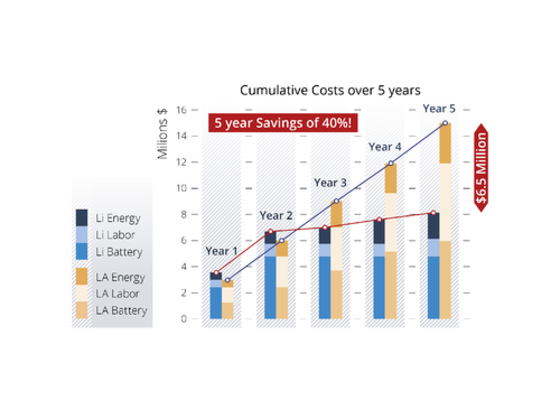Upload your press release
Lithium Battery Price: Good Investment?

The average cost of a lithium-ion battery is between $3,000 and $20,000, depending on battery size. This price tag can be up to twice as much as the average purchase price of a lead acid battery. However, when you factor in the long-term costs, a lithium-ion battery is less expensive than a lead acid battery.
Lithium-ion batteries offer significantly more benefits that make them a better long-term investment for most companies. Here’s why.
A Longer Lifespan
One of the first attributes a manager looks at is the average lifespan of a battery type.
A battery with a longer lifespan generally makes it a more valuable investment. If employees properly maintain the batteries in their fleet, the average lifespan of a lithium-ion battery is between 2,000 and 3,000 cycles.
A lithium-ion battery’s lifespan is twice as long as the average lifespan of a lead acid battery, which is between 1,000 and 1,500 cycles.
Batteries with shorter lifespans need to be replaced more often, and you may need at least two lead acid batteries to last the lifespan of one lithium-ion battery.
Longer Run Times
How long a battery runs before it must be charged impacts productivity and the overall efficiency of an operation.
Lithium-ion batteries typically run about 7.2 hours before requiring a charge. And, they can be safely discharged down to 20% capacity.
Lead acid batteries, on the other hand, require charging after about 5.4 hours of use. And, they can only be safely discharged down to 30% capacity.
The longer a battery is in service, the more cost-efficient it is to an operation. Swapping batteries after just 5.4 hours of use can lead to costly downtime for employees who must then remove the batteries from equipment and replace them with charged batteries so equipment can go back into service. This takes away productive time.
Shorter Charging Times
Lithium-ion batteries take just 1 to 2 hours to charge. They can be opportunity charged in between shifts or while employees are on break. Because of this, only one lithium-ion battery is typically needed per piece of equipment, regardless of how many shifts a company works.
Lead acid batteries require 8 hours to charge and another 8 hours to cool down. This means that the true amount of time needed for a lead acid battery to charge and go back into service is closer to 16 hours.
This is key for companies that have multi-shift operations. If a warehouse operates 24 hours a day, equipment that is powered by lithium-ion batteries can be opportunity charged a few times throughout the day. That means one lithium-ion battery can be used for the entire duration of the 24-hour period as long as it has been charged.
If using lead acid batteries to power equipment over the course of 24 hours, one piece of equipment would require three lead acid batteries since workers would need to completely replace the battery after approximately 5 to 6 hours of use and then charge and cool it for 16 hours.
In other words, managers must purchase three lead acid batteries for each piece of equipment to cover a 24-hour period.
Saved Labor Costs
Labor costs are key to determining the true cost of a battery. As mentioned above, lithium-ion batteries can be opportunity charged quickly and efficiently. The process of charging a lithium-ion battery can also save a company substantially in labor costs.
That’s because lithium-ion batteries:
* Remain in the equipment during charging
* Do not require transport to a separate charging space
* Do not require extra time to refill the battery with an electrolyte solution
In contrast, when charging a lead acid battery:
* An operator must use special lifting equipment and because of the battery’s weight, trained personnel must then remove the battery and place it on a storage rack where the charging will be done
* The battery is then charged for approximately 8 hours.
* Once the charging process is completed, the cooling down stage begins. This lasts an additional 8 hours.
The battery will either remain where it was charged or personnel may transport it to a designated cooling area, if the space is needed in the battery room to charge other batteries.
Click the link below for full article or to subscribe to our blog.
https://www.fluxpower.com/blog/lithium-battery-price-good-investmentRelated Articles
Copyright ©2024. All Rights ReservedDesign, CMS, Hosting & Web Development :: ePublishing